The ultimate home cinema processor – and how film premieres at home are on the way
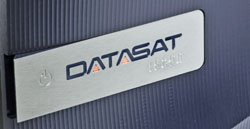
I've just spent the day at Datasat, and I think I may have seen the future of home cinema.
If you've not been paying attention to your movie posters of late, you may be forgiven for saying 'Datasat – who?'
Well, since May 2008, Datasat has been the parent company of DTS Digital Cinema, and while the original California-based company, DTS, Inc., continues to develop and license home products, the work for the world's cinemas is now handled by Datasat.

Since last year the DTS brand on movies has been replaced by Datasat's – the first film to carry the new brand was alien comedy Paul, released in February last year, with a dramatic alien-themed Datasat Digital Sound trailer released soon after.
At its UK base near Reading, the company not only makes and services its processors for cinema use, but also combines soundtrack and pictures for cinema releases: for 35mm film, that means synchronising soundtracks burnt to disc with the time-codes on the film, then checking every aspect of the sound, listening for extraneous noises and the like.
And it does it for every language, and also for audio-description versions and so on.
Interestingly, much of the assessment of soundtracks is done without the pictures running, as this is the way to best concentrate on the sound – which calls to mind one of the best pieces of advice I was given many years ago: if you want to hear just how good (or bad) your home cinema system is, turn off the display for a while and just listen.
The latest hi-fi, home cinema and tech news, reviews, buying advice and deals, direct to your inbox.

In an storeroom at the back of the company warehouse is what Datasat calls its vault – shelf after shelf of boxes of discs, carrying the soundtracks of every movie that's been through the process here.
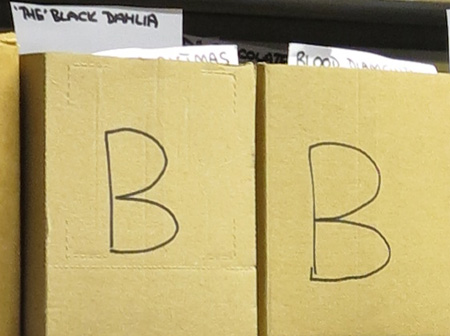
So do they sneak the odd company showing of a movie before it's even released? Sometimes, when the studio gives them permission, explains Sales Manager Daniel Gray, who goes on to tell us that when they were handling The Dark Night Rises only one member of staff was allowed to watch the film, with Warner Bros people lurking at his shoulder at all times.
The obvious question from his colleagues when he'd finished, 'So, how was it?', was met with a simple 'I can't tell you.'
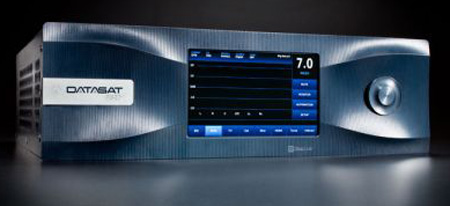
So, that's what Datasat does in the cinema; now the company is bringing its pro expertise into the domestic market with the launch of a very upmarket – and amazingly capable – home cinema processor, the RS20i (above).
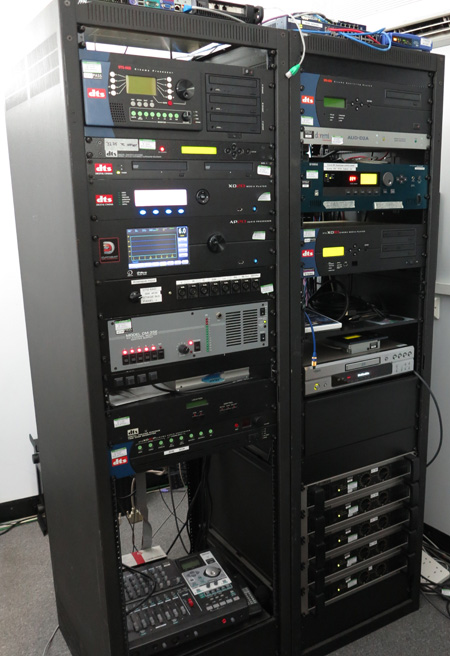
The company emphasises that this new product is as close as the home cinema enthusiast is going to get to the state of the art AP20 processor found in racks like the one above in cinemas worldwide.
In fact, the RS20i is effectively the pro processor with the addition of features such as bass management, and some commercial features such as 35mm capability relegated to optional modules.
To introduce it, Datasat held a 'get to know' training day at its UK headquarters yesterday. The idea was to give installers, distributors – oh, and one member of the UK press! – an introduction to the company, and the processor, and I have to say that having sat through the extensive presentation of the product, and a couple of brief demonstrations of what it can do, I'm left somewhat jaw-dropped by the whole thing.
Not least because of a nagging feeling that, amazingly comprehensive though the capabilities of the unit may be, we were only scratching the surface of what it can do.
After all, as Stephen Field, Datasat's Senior VP of Global Programs and Products, explained to us during the day-long session, taking in 200+ PowerPoint slides, the course he was giving to a group of a dozen or so people gathered in the metting room is usually designed for three or four attendees, and takes more than twice as long.
On several occasions Field gave us live demonstrations of the set-up, then found the following slides went over the same ground. He apologised for the back-tracking; I was grateful for the opportunity to play catch-up!
85 inputs, 16 channels, 34 audio outputs – and more
Just to give you some idea of the capabilities of the RS20i, it can handle up to 85 digital and analogue inputs, and deliver 16 channels of digital audio into up to 34 audio outputs. That means you can easily accommodate formats such as 11.1, 12.2 or even 12.4, and should you want you could biamp or triamp as many channels as you wanted, or even run every channel into a separate DAC and then on to its own amplifiers.
That enables it to handle all current and 'on-the-way' surround formats, including 3D sound, while expansion slots will allow extra channels to be added in the future, and a modular construction will accept cards to expand its processing capabilities. For example, right now the processor does DTS-HD Master Audio/DTS ES/DTS 5.1 and Neo;6, plus Dolby AC3, but as soon as certification is achieved it will be upgraded with a Dolby TrueHD decoder card.
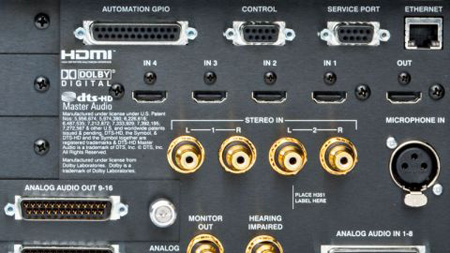
There are four HDMI inputs and one output, two optical and one electrical S/PDIF, and two stereo analogue inputs, but beyond that, the rear of the RS20i is going to look a bit unfamiliar to most home cinema enthusiasts.
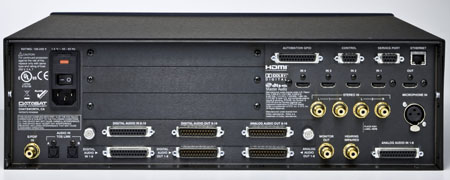
That's because – to increase flexibility and avoid the rear panel space requirements forcing the unit to be absolutely enormous – most of the connections are on 25-pin D-Sub connectors, which can be used to hook up cables with suitable connectors for sources and power amplifiers, or even break-out boxes offering the same functionality.
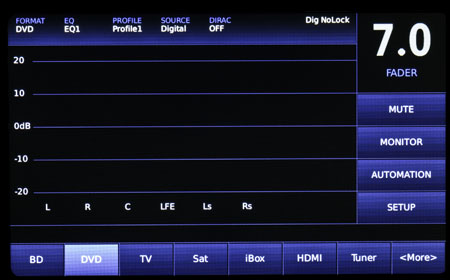
Up to 20 input selections can be programmed, and on each not only the inputs source and format can be saved, but also output channel profile, and equalisation.
Ah yes, equalisation: the RS20i offers 3rd Octave EQ over 16 channels, with 31 user-adjustable bandpass filters, from 20Hz to 20kHz, and with gain adjustable +/-6dB in 0.5dB steps. There's also 16-channel parametric equalisation for shaping subwoofer response, working from 20-200Hz, this time in 0.1dB steps, and the ability to set up active crossovers from 20Hz-20kZ, with adjustable slope from 6dB to 24dB/octave.
All of a sudden, what you get on your average home cinema amp looks a bit simple, doesn't it? But the RS20i is still going: it also offers that bass management, with separate settings for up to four subs, and that's before we even get to the Dirac Live Room Optimisation capability.
Using a separate Dirac Live Installer Kit, which will set you back around $2000 or so – after all, this is a unit designed for custom installation, rather than the kind of thing you or I could set up on a wet Saturday afternoon with the family bawling 'Hurry up – it's almost time for…' –, this allows 16-channel room analysis and measurement, and then lets the installer adjust the settings, based on a minimum of nine measurement positions, to get the flattest possible response for each channel in the room.
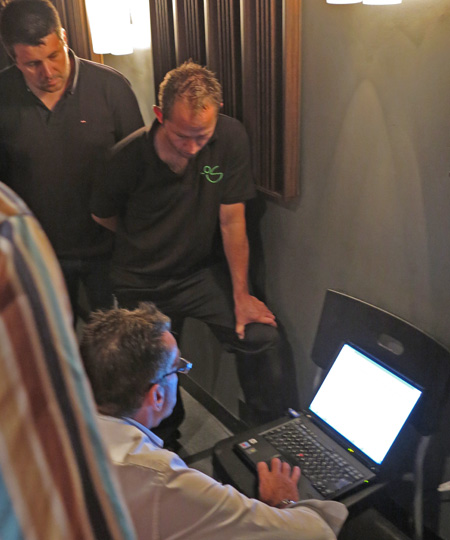
As Field, seen demonstrating the system in the cinema, explains it, 'this isn't the kind of "push a button, go have a cup of coffee and it's all done" system you get in consumer processors', but rather a very powerful tool for system set-up.
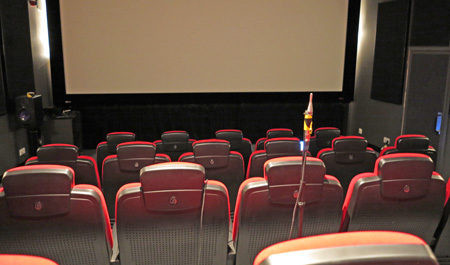
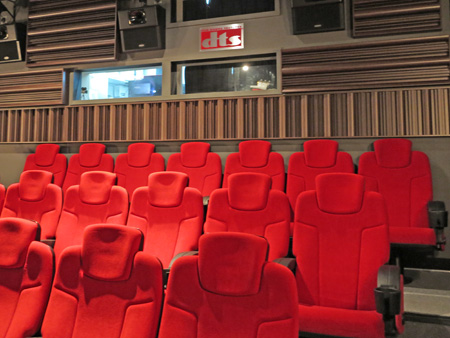

In fact the kit we got a taste of in Datasat's superb in-house theatre, which is set up for both 35mm film and digital projection, is exactly the same one used when setting up the company's professional processors in cinemas around the world.
Field had recently returned from the Phiippines – where several hundred Datasat processors have just been installed – and simply unpacked his travelling kit, fired up the laptop, and showed us how it works.
And of course you can still add all the other layers of EQ on top of the Dirac Live settings – no wonder it takes a two-day certification course before Datasat will even sell you the set-up kit!
The RS20i also offers a whole range of automation options, control from a laptop or tablet, integration with network operation and a range of industry-standard custom installation systems and more.
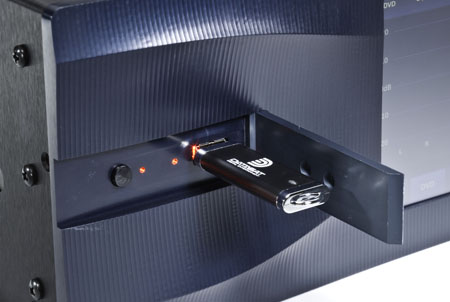
It's hardly surprising, then, that the unit has a USB slot on the front, hidden with the power switch under a flap, purely for the storage and upload of its settings, and can also be accessed remotely if required to make settings – or indeed put things right if the user starts to fiddle and gets things all crossed up.
The company is also building both stereo and seven-channel amplifiers to partner the RS20i, which is currently being hand-built in-house, but will soon be made for the company by suppliers in the UK and USA: Field explains that the amps will daisychain to the processor using those D-Sub connectors, keeping connections simpler for the installer.
So, time to answer the question you've probably been asking since you started reading this: £16,000. Including VAT.
Sharp intake of breath time? Understood, but when Datasat founder and owner Phil Emmel drops in for a short time to explain the company, and where he sees it going, it all starts to make sense.

As pictures in the lobby of the building show, Datasat, as the name suggests, was built on high-security data communications, for clients including governments and industry. Emmel started out providing services for the London Stock Exchange, and Datasat Communications currently supplies secure comms for the likes of British and other embassies worldwide, the oil and mining industries, and Large File Transfer systems able to deliver huge amounts of data to multiple destinations worldwide. Yes, like movies to cinemas…

Emmel (left) says that a few years back he decided to retire from the communications company – 'It was getting too big; it'd stopped being fun and I was spending too much time in meetings' – and it was then that the opportunity to acquire DTS Digital Cinema came up: 'I bought it because a) I'm into audio, and b) I was interested in digital transmission of film.'
He explains that the company has been seeing a changing trend in high-end home cinema systems: whereas once those with serious money spent it on houses with lots of rooms, now it seems they're building three or four bedroom properties and spending the money on high-end kitchens – and home cinema rooms.
That's a sector Datasat will be targeting, working closely with projector and server specialists to bring systems compliant with the DCI (Digital Cinema Initiatives) standard into home systems.
And with that in place, the Datasat vision is that those prepared to pay for the privilege will be able to have major Hollywood movies, with sound and vision as good as in any cinema, delivered into their home facility on the same day they're released.
Or as Emmel puts it, 'We're trying to pull Hollywood sound all the way through to the home: the company who've done the sound for the movie can bring cinema quality and first run movies into the home.'

Part of that is the move up to 3D sound, and in particular the up-to-13.1-channel Auro3D sound system, on which Datasat is working closely with partners including Barco, and which adds not only height channels but what Field refers to as the 'voice of God' channel above the audience.
Datasat already has a commercial processor, the AP24-3D, which is able to switch between anything from 5.1 to Auro3D 13.1, depending on the cinema's configuration – thus allowing a single version of the movie to be distributed, playable in any cinema from 5.1-channel upwards, and indeed any mix of a movie to be scaled up to cinemas running Auro3D systems – and its UK viewing room is soon to be refitted for this technology.

The first movie, Red Tails, has been released using the system and, as Emmel says, 'as the Blu-rays start appearing with Auro3D 11.1-channel soundtracks, subject to license we'll have a card that plugs straight into the RS20i to decode them.'

And the first Blu-rays are beginning to come through: already Norwegian label 2L has its first music release, Souvenir, available with a large number of audio formats including DTS-HD Master Audio 192kHz/24-bit 5.1, DTS-HD Master Audio 96kHz/24-bit 7.1 and Auro3D 96kHz/24-bit 9.1-channel.
But Datasat's thinking goes beyond first-run movies in your home and 3D sound: with its content distribution abilities, the company is well-placed to bring to the home cinema the kind of events increasingly being seen in cinemas: sports, operas, concerts and the like, delivered via DCI-compliant technology.
With that in mind, the Datasat strategy makes a lot of sense, going way beyond the obvious high-end home cinema concept: I couldn't help feeling the distributors and installers gathered around the table were already considering clients for whom their own day and date movie premieres, not to mention access to super-high-resolution transmissions of leading events from around the globe, would be a compelling reason for a serious investment in home entertainment technology.
Now if only we'd won that £115m last night...
Andrew has written about audio and video products for the past 20+ years, and been a consumer journalist for more than 30 years, starting his career on camera magazines. Andrew has contributed to titles including What Hi-Fi?, Gramophone, Jazzwise and Hi-Fi Critic, Hi-Fi News & Record Review and Hi-Fi Choice. I’ve also written for a number of non-specialist and overseas magazines.
